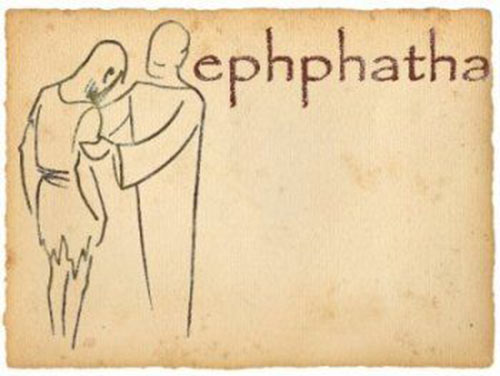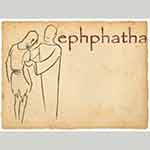
Sunday, last week, we prayed with Mark 7:24-37 including:
They brought to Jesus a deaf man who had an impediment in his speech; and they begged him to lay his hand on him. He took him aside in private, away from the crowd, and put his fingers into his ears, and he spat and touched his tongue. Then looking up to heaven, he sighed and said to him, “Ephphatha,” that is, “Be opened.” And immediately his ears were opened, his tongue was released, and he spoke plainly. Mark 7:32-35
In lectio, praying that we may be open to hear and speak is a wonderful connection with this reading.
“Ephphatha” is an Aramaic word. Other times the Aramaic is not translated are: “Talitha koum” (Mark 5:41), “Abba” (Mark 14:36), “Raqa” (Matthew 5:22), “Rabboni” (John 20:16), and “Eli, Eli, lema sabachthani” (Matthew 27:46; Mark 15:34).
Six years ago, when we were all reading the Ephphatha Gospel passage (above), Pope Benedict XVI, in his Sunday Angelus address, said that if you were going to summarise the mission of Jesus Christ in one word, Ephphatha could be that word.
The earliest record of it used in a prebaptismal ceremony is in the Gelasian Sacramentary (C7) on Holy Saturday (#42). It takes place after an exorcism and before anointing with the oil of exorcism and the renunciations of Satan. The rubric for the bishop can be translated as: “Then you touch [the catechumen’s] nostrils and ears with spittle and say into their ear: ‘Ephphetha, this is be opened, to a sweet aroma. But you, devil, flee, for the judgment of God has come near.’”
After Vatican II, this rite was moved for children to after baptism (read further here – off site). Hence, there is now a continuation in sacramental practice. In baptism there is the tradition of the
Ephphetha or Prayer over Ears and Mouth
If the conference of bishops decides to preserve the practice, the rite of Ephphetha follows. The celebrant touches the ears and mouth of the child with his thumb, saying:
The Lord Jesus made the deaf hear and the dumb speak. May he soon touch your ears to receive his word, and your mouth to proclaim his faith, to the praise and glory of God the Father.
All: Amen.
In Australia and New Zealand, that is simply part of the rite. In the United States it may be performed at the discretion of the one baptising.
It can be part of the catechumenal process (RCIA) on Holy Saturday (read more, off site).
If you appreciated this post, do remember to like the liturgy facebook page, use the RSS feed, and sign up for a not-very-often email, …




I would like to use the art work “Ephphthala” for my diaconate ordination holy cards. It would be limited to a 100 or less cards. They have been printed due to time constraints pending your permission. Praying you will allow this very limited use.
Blessings,
Kevin
Dear Kevin – congratulations and blessings on being ordained deacon. As is clear on this page, the image is not mine, and I link to the source. Blessings.
Thank you, Father! I will take my inquiry to the source. My apologies for not seeing that and my thanks for your well wishes.
Kevin
All good, Kevin. Blessings.